Episode 4. Simon Benjamin
For the fourth episode of our series, we visited Simon Benjamin's studio at Sharpe-Walentas Studio as he was finalizing his presentation for NADA House in the Governors Islands. The new body of work continues Benjamin’s geographical research of the sea and island regions as interconnected sites of colonial legacy. Through video installation and sculpture we are immersed in visual and auditory vocabularies that convene relational coastal histories alongside material objects of inquiry.
WATCH.
CONNECT.
How would you describe your current studio?
“I’m working in the Sharpe Walentas studio program, an amazing studio residency in DUMBO, Brooklyn. The large studio is in a former industrial space, with high ceilings and beautiful wood floors that show the passage of time. One of my favorite things about the program is that they have a list of people who were in the studio before, just outside the door. I am super grateful to be in this space and contribute to the legacy of the program.
The space is big enough to have multiple workstations and a big couch to chill on. The bigger studio has allowed me to work at a larger scale, which I have really enjoyed and has opened up the possibility of bringing new layers of meaning in the work.
Having this space has also allowed me to work with different mediums simultaneously and have the works interact with each other in the same space, a luxury that typically only occurs during an exhibition installation.”
Simon Benjamin, Coin Diver I, 2024, Silkscreen On Canvas With Acrylic Paint, 72 H x 60 W in. / 183 H x 152 W cm.
You’re currently working on your upcoming show. Can you tell us more about that title and some of the leading themes or sensations driving these new works for the show?
“I’m working on a few things at the same time, preparing for the NADA House exhibition, titled A Bolt from the Blue, which includes a video installation with an immersive soundscape, sculptures cast in cornmeal, sand, and coastal detritus that respond to the geography and history of the place, and paintings draw from archival imagery, inspired by my research on coin divers, young men in the Caribbean, that bore witness to the shift from plantation economies to the mass tourism industry in the early 20th Century.
This body of work is influenced by the writings and poetry of Édouard Glissant from Martinique and Kamau Brathwaite from Barbados. Both of them provide poetic and critical examinations of the significance of islands as a place as both a paradise and a site of historical and daily survival. I envision this collection of work as an ongoing, open-ended conversation or “reasoning,” as it is referred to in Jamaica, with elders across the Caribbean, as well as with the land and seascapes that hold their own stories.”
Simon Benjamin, CORE: H.CT. 2023, 2023, Cornmeal, Beach Detritus, Sand. Antique Glass Case, Shipping Crate, 36 H x 48 W x 36 D in. / 91 H x 122 W x 91 D cm.
Is there anything you like to listen to/watch/read/look at etc. for inspiration?
“I’m never not working—living and moving through the world informs and inspires my practice. My projects usually begin with an idea or a question I am thinking through that will often surface outside the studio. So, early mornings at home, running in a park, swimming or surfing, or even in the shower are places I will begin to process ideas and thoughts, and I consider the start of the work day.
When it comes to making the work physically in the studio, I switch between art and history podcasts and NTS Radio, an online radio station that turns me on to all kinds of music in different genres, from Jazz and Cumbia to piano music to Amapiano. I like that there’s an element of chance when you tune in, and they have an epic archive of their shows to dig through, keeping it fresh and interesting. ”
What tool or art supply do you find yourself to enjoy the most in working?
“I recently got a medium format film camera and a Super 8 movie camera, so I am excited about experimenting with film and analog processes, as a way of making images, and how that might translate into the other mediums I work in. ”
Simon Benjamin, The Divers Through A Waterglass, 2024, Silkscreen On Canvas With Acrylic Paint, 72 H x 186 W in. / 183 H x 472 W cm.
Name your favorite Drink Spot.
“Rodeo, a new bar in Crown Heights, in Brooklyn opened by a friend from grad school, artist Jameson Magrogan. Another friend, Stephanie Bapitiste of Medium Tings, was using the same space as a gallery a few years before. NYC is a small town.”
Name your favorite Coffee Spot.
“I usually have my coffee at home – a french press with Jamaican Blue Mountain Coffee.”
Favorite Sunday Spot.
“I don’t leave Brooklyn. I try to run in Prospect Park in the morning, and I like laying out a blanket in Fort Greene Park evening with beer or wine.”
LISTEN.
“Bob Marley & The Wailers - “Survival” Album, from 1979. I have been listening to this album a lot recently, a lot of the lyrics still resonate today. In what is considered one of Marley’s most militant albums, I also see it as one of his most optimistic. Marley’s lyrics address political unrest in Jamaica as well as systematic oppression, such as the apartheid regime in South Africa, and chants for the liberation and unification of colonized states across the continent of Africa. There is a lot still to be done towards a more equitable and just world; it is encouraging to know that freedom and civil liberties for oppressed peoples are possible, and apartheid regimes can and do end.”




